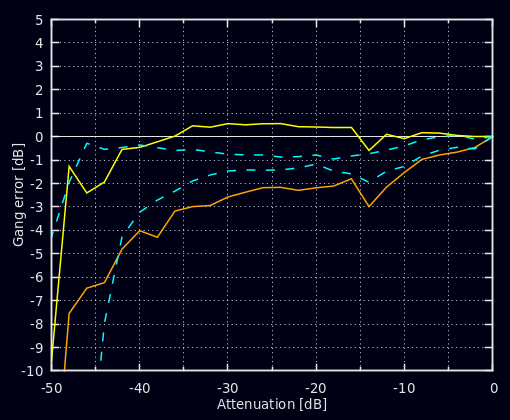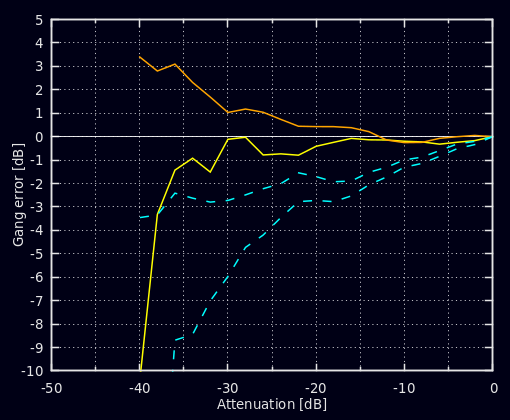2-Stage Volume Controls
When sound quality matters, the quite remarkable channel balance errors caused by conventional volume potentiometers can easily become unacceptable, especially at low listening levels where potentiometer accuracy is most critical. Typical gang error specification for logarithmic dual potentiometers is 3 dB which, however, applies only down to -20 dB attenuation, which in practice covers only the right half of knob travel, and nothing is promised below that. Matched multi-gang potentiometers are usually available only for large-scale customers for extra price. One known manufacturer does specify gang error over the whole practical attenuation range, but these limits can still be inadequate, or genuine units may be hard to obtain in many parts of the world.
Aside from digital solutions, the usual fix to the problem is to employ a long-stringed stepped attenuator, where accuracy depends on fixed resistor values. While these offer near perfect channel balance, there is a number of downsides:
- The number of steps has to be very large (often 24) in order to keep the step size reasonably small over the whole needed range. This makes the implementation sizable and tedious.
- The step size achieved is usually 2 dB or more, which can be an inadequate resolution for some.
- Dual rotary switches with such high number of positions and prime quality are hard to obtain at an affordable price.
- Clicking through all intermediate positions in large adjustments can be annoying.
- Some are concerned about the added noise that is thought to increase with the number of resistors in the signal path.
These drawbacks can be ameliorated by using a two-stage approach with coarse and fine adjustments operated by two smaller knobs instead of one big. The fine adjustment can also be implemented with a linear-law potentiometer while still retaining tight enough channel balance. Two attenuator circuits with two design versions of each are presented below:
Measured Gang Errors
In order to get some idea of the actual matching errors occurring in dual potentiometers, a few samples were measured from two reputable manufacturers, as no such data seems to be found anywhere out there. The first figure shows the results of logarithmic pots and the second of linear ones, all supposedly plastic tracks.
In two (old) samples (of the same brand), the gang error was strongly dependent on the direction from which the desired point was approached. Due to this mechanical hysteresis, these had to be measured separately for both moving directions (up or down) and are shown with dashed lines.
Though the sample size is small, the results don't encourage using a bare potentiometer for volume control, at least without prior testing. In log pots, matching seems to collapse totally below -40 dB and can be unacceptably poor at almost any setting. Also, the often held notion that linear pots have better matching doesn't get support from this experiment.
Yellow: 10k log; orange: 47k log; blue: 100k log.

Yellow: 10k lin; orange: 47k lin; blue: 10k lin.


